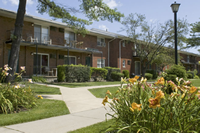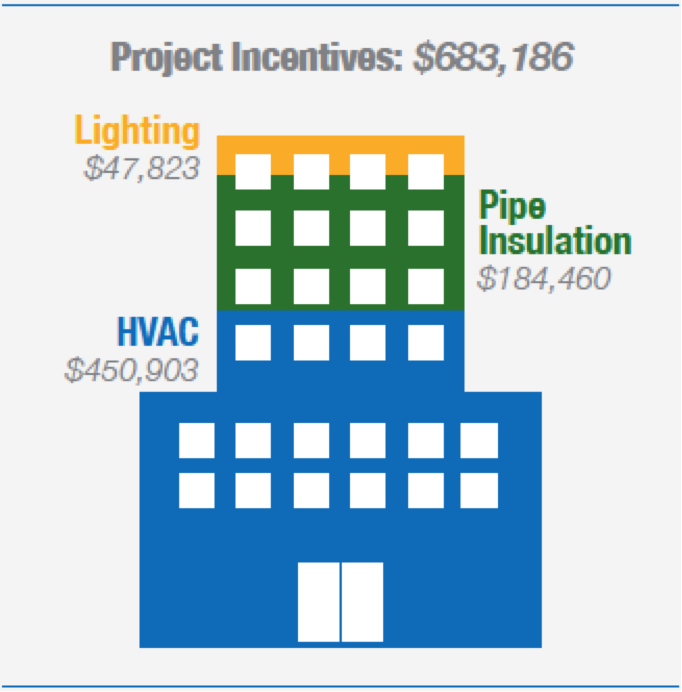Success Story: Troy Hills Village
| Project Highlights | ||
| Total Project Cost | $1,480,000 |
 Troy Hills Village, a 752-apartment community with about 1,500 residents, overhauled its HVAC system with new condensing gas boilers, premium pumps and VFDs. Insulation was added to more than 21,000 feet of hot water pipes across the community. |
| NJCEP Incentives | $683,186 | |
| Project Payback | 5.5 years | |
| Estimated Annual Savings | $208,927 197,927 kWh 23,568 MMBtu |
|
| Partner | Energy Solutions | |
| Technologies
LED lighting; condensing gas boilers; premium pumps; variable frequency drives; hot water pipe insulation |
||
| Project information, savings and environmental benefits were provided by the project contact. | ||
|
Apartment community owners and tenants save big through Pay for Performance program Background Bernie Adler built his first apartment community back in 1963. Much has changed in the 52 years since. His company, Adler Development, now holds some 2 million square feet of commercial property and more than 800 multifamily residential units under the Adler Residential umbrella. Among properties that broke ground in the mid 60s is Troy Hills Village in Parsippany, New Jersey in Morris County. The 41-building, 752-apartment community is home to about 1,500 residents. As Adler’s children joined the company, they began to focus more on green building initiatives such as energy efficiency improvements and solar installations. This included a focus on the Troy Hills Village’s heating, ventilation and air-conditioning (HVAC) system. The apartment community was centrally heated using hot water boilers and cooled with individual window-type air conditioners. “When we started to see the equipment we were operating was 83-percent efficient, and newer equipment was in the 95-98 percent range, I started looking into how to leverage that,” said Matthew Adler, a partner of Adler Residential and one of three Adler sons who joined the family business. Matthew Adler turned to New Jersey’s Clean Energy Program™ (NJCEP) to determine the equipment that would be cost effective to replace, identify contractors best suited to implement the efficiency upgrades, and to receive financial incentives that are expected to reduce the project cost by half. |
|
|
Our equipment wasn’t necessarily in line for replacement, but it wasn’t the most efficient either. It makes sense to spend money now to immediately begin saving energy and begin operating more efficiently. And, in the long run, we know we’ll be saving. Matthew Adler
Adler Residential
|
Solution Adler participated in the NJCEP Pay for Performance program to maximize energy savings at Troy Hills Village. To achieve these goals, the program studied energy use at the apartment community over the previous 12 months in order to develop an energy reduction plan. The reduction plan encouraged Adler to undertake a large-scale overhaul of the HVAC system. The community’s boilers and pumps were replaced with a combination of 500 MBH (a measurement of British Thermal Units, or BTUs, per hour) and 200 MBH condensing gas boilers, premium pumps and variable frequency drives (VFDs). Analog and digital controls were exchanged for remote access units for the boilers and pumps, and programmable thermostats were installed in the apartments. In addition, more than 21,000 feet – nearly four miles – of hot water pipes across the community were wrapped with insulation. The common areas and all exterior lighting were upgraded to LED fixtures. By reducing energy use at least 15 percent, Troy Hills Village was eligible for Pay for Performance incentives of $683,186 out of a total project cost of $1.48 million. The new equipment is expected to save 197,927 kWh and 23,586 MMBtu, amounting to $208,927 in estimated savings each year. "Residents are likely to benefit from the cost savings as well. As management costs rise in the future, the energy savings will help avoid larger rent increases," Adler said. “The Clean Energy Program allows us to continue to put value back into our property by making a substantial investment in high-efficiency equipment,” Adler said. “The program is a big win for our residents, our property and the environment.” |
More Information





.jpg)

.jpg)


